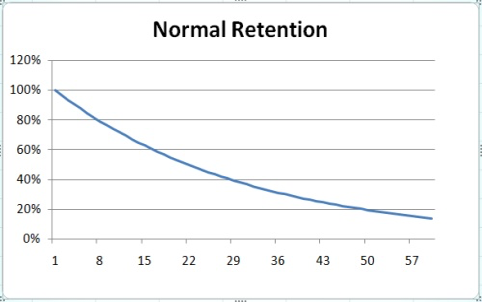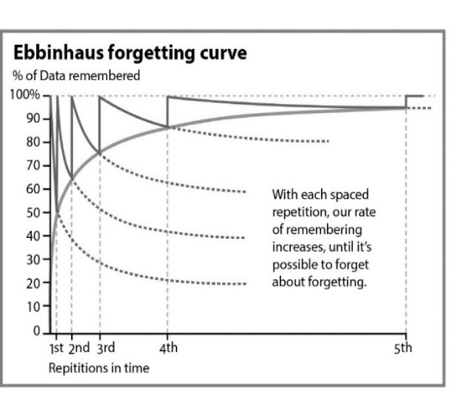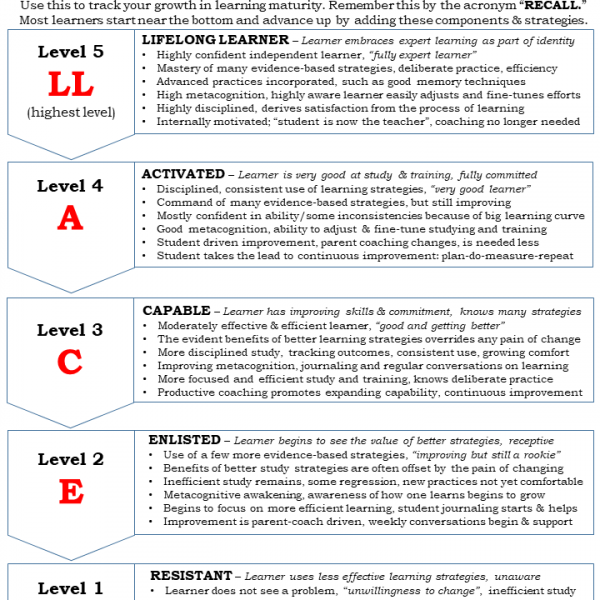
Why Your Child Needs Better Learning Strategies

Reading time: 8 minutes
Understanding the Science of Forgetting
This article will help you gain new insights and have deeper conversations with your child about learning strategies and how to study smarter. Read this to improve your knowledge of learning and use the discussion points at the end to talk with your child about more effective learning.
Fun Quiz – How Much do You Know about Learning?
Start by testing your own knowledge. Answer this question:
A person reads a chapter in a book and highlights some key points. How much of the information will still be retained after two days?
- 66%
- 50%
- 33%
- 20%
See the correct answer at the bottom of this article.
How did you do on this quiz? Most people are not aware how inefficient traditional ways of studying can be. This is a huge takeaway for parents. At the Center for Homeschooling, this is the reason we emphasize better learning strategies. Without the right strategies, learning can be highly inefficient – while on one side you work hard to put information in, your brain has been wired to actively engage in an opposing process of sorting through information and getting rid of information it decides is not relevant. Information in, information rapidly out.
This means a student can be studying and experiencing the “illusion of learning.” At the very moment, it felt like you got a lot of new information, only to find it has somehow quickly vaporized into the air!
To better understand how you can remember better, we need to go back in time to a German researcher almost a hundred and fifty years ago.
The Ebbinghaus Forgetting Curve
German psychologist Hermann Ebbinghaus was among the first scientists to perform experiments to understand how memory works. He discovered this through his experiments of memory in the 1870s. His studies showed that, without deploying memory techniques or learning strategies, after reading or being exposed to information, only about twenty percent of it will be retained 48 hours later.
Of course, we are all aware of this memory decay problem, but its effects are highly underestimated by most learners and therefore not properly addressed.
This provides a fundamental reason why we need to understand the science of learning. Practically speaking, if you are reading a book and engaging in a single ineffective memory technique like highlighting passages, in one day you will have lost half the information, and in two days you will have lost 80 percent of the information you just read. This means your efforts at learning were largely a waste of your, or your child’s time. However, this loss is preventable through proper skills and technique.
Here’s what Ebbinghaus found, and it’s pretty amazing. His chart below shows the effect of memory decay in hours after studying something once. The horizontal axis is plotted in hours. Note how steeply retention drops in 24 hours, then 48, and that it continues to keep dropping. This is why your brain needs help to remember things. 
Of course, this curve describes what typically happens for people in general. Each person is unique, and some people will retain more information for specific topics longer than others. If you are really interested in something you may remember more longer, and if you are not, you may experience even more rapid decay. But memory will decay over time without proper strategies.
So, how can we do a better job of retaining information? The science of learning tells us there are two important factors:
- Repetition
- The quality of “memory representation”
Spaced Repetition
First lets’ focus on repetition. Ebbinghaus discovered the best intervals for doing this. Note below that when you properly space study sessions apart so they are timed to occur when you are just starting to forget (early memory decay) information, you can solve the forgetting curve.
Note in the chart below how properly spaced practice brings the retention back.
 The important point is that same number of hours clustered in one study session, are much more effective when distributed across multiple sessions timed to when forgetting is just starting to occur. For example, one four-hour session is inferior to four spaced one-hour sessions.
The important point is that same number of hours clustered in one study session, are much more effective when distributed across multiple sessions timed to when forgetting is just starting to occur. For example, one four-hour session is inferior to four spaced one-hour sessions.
The Quality of Memory Representation
Next, the best approach for long term retention is to focus on the quality of information and use techniques to tie it to what you already know. This is much better than “power learning” approaches where the student tries to force the information in by brute effort and repetitive review such as multiple rereading of a passage of chapter hoping it will finally “stick.” Also, focus on the meaning of the information to you.
“Instead of trying to pound information into your brain with the hopes it will simply fall out when you need it, holistic learning is the process of weaving the knowledge you are learning into everything you already understand.”
– Scott Young, “Learn More, Study Less”
The idea is to connect the new information to the matrix of things you already know. The more ways you connect, and the more meaningful these are, the better your memory, retention and recall will be over time. The more senses you can involve in remembering something, the more connections you will have and the more ways you will have to recall the information.
To summarize:
- If you want to learn something, connect it with many things you already know. The more and better you can tie this to a matrix of current knowledge – the better your memory retention will be.
- If you want to learn something, but you cannot or do not connect it with things you already know, your memory retention will be weak. In this case you will have to over rely on the repetition strategy described above.
The key point is that efficient learning uses both, not just one.
The Difference between A and B Students
How important are the right learning strategies to learning and better retention? In one well known study, Cal Newport, author and teacher, discovered that college students who got “A’s” studied less than those who got “B’s!” How could this be? He found this was not because the “A” students were smarter or had higher IQs, but because they used better learning strategies.
This underscores the importance of using effective learning strategies at home.
These points should provide profound insights on why the study activities your child uses should be discussed and coached. Because the costs of poor strategies are so high in terms of wasted time and effort, and the potential payoffs of effective strategies are so significant to effective learning, parents are wise to spend time understanding what their children are doing when studying and then collaboratively exploring how to get better.
Related Strategies
There are many other learning strategies that can help greatly with repetition and representation of information. Three are recitation, self-testing, and mnemonic techniques.
For more information, go to: Pa 10 course, or Pa 102 course.
Have some fun and share this quiz with your child. Then start a conversation on what you might do to prevent the rapid memory decay that Ebbinghaus discovered 150 years ago. Pretty cool – old knowledge becomes new knowledge!
Discussion Points for Parents
After you share this information with your child, ask some good questions to enable deep conversations on learning.
- What is the forgetting curve? How fast does it happen?
- Since memory decays rapidly without study strategies, how can you avoid the forgetting curve?
- What did you learn about the importance of repetition to learning?
- What was spaced learning? How can you do more of this when you study?
- What does the quality of memory representation mean? How can you apply this?
Quiz answer
The correct answer is D – 20 percent. Most students overestimate their ability to retain information. This results in the repeated use of inferior learning strategies. The use of evidence-based learning strategies can greatly improve the ability of your child to remember and recall information. By the way, highlighting is not an effective learning strategy, it doesn’t help the brain remember, its only useful for returning to a page to locate information.






